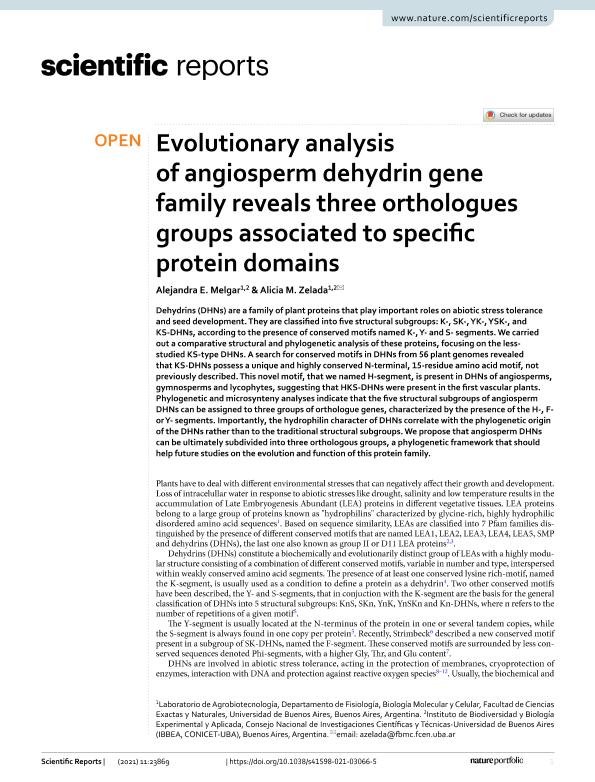Mostrar el registro sencillo del ítem
dc.contributor.author
Melgar, Alejandra Estefania

dc.contributor.author
Zelada, Alicia Mercedes

dc.date.available
2022-12-19T10:52:07Z
dc.date.issued
2021-12
dc.identifier.citation
Melgar, Alejandra Estefania; Zelada, Alicia Mercedes; Evolutionary analysis of angiosperm dehydrin gene family reveals three orthologues groups associated to specific protein domains; Nature; Scientific Reports; 11; 1; 12-2021; 1-12
dc.identifier.issn
2045-2322
dc.identifier.uri
http://hdl.handle.net/11336/181685
dc.description.abstract
Dehydrins (DHNs) are a family of plant proteins that play important roles on abiotic stress tolerance and seed development. They are classified into five structural subgroups: K-, SK-, YK-, YSK-, and KS-DHNs, according to the presence of conserved motifs named K-, Y- and S- segments. We carried out a comparative structural and phylogenetic analysis of these proteins, focusing on the less-studied KS-type DHNs. A search for conserved motifs in DHNs from 56 plant genomes revealed that KS-DHNs possess a unique and highly conserved N-terminal, 15-residue amino acid motif, not previously described. This novel motif, that we named H-segment, is present in DHNs of angiosperms, gymnosperms and lycophytes, suggesting that HKS-DHNs were present in the first vascular plants. Phylogenetic and microsynteny analyses indicate that the five structural subgroups of angiosperm DHNs can be assigned to three groups of orthologue genes, characterized by the presence of the H-, F- or Y- segments. Importantly, the hydrophilin character of DHNs correlate with the phylogenetic origin of the DHNs rather than to the traditional structural subgroups. We propose that angiosperm DHNs can be ultimately subdivided into three orthologous groups, a phylogenetic framework that should help future studies on the evolution and function of this protein family.
dc.format
application/pdf
dc.language.iso
eng
dc.publisher
Nature

dc.rights
info:eu-repo/semantics/openAccess
dc.rights.uri
https://creativecommons.org/licenses/by/2.5/ar/
dc.subject
DEHYDRIN
dc.subject
H DOMAIN
dc.subject
EVOLUTION
dc.subject
PROTEIN DOMAINS
dc.subject.classification
Biología

dc.subject.classification
Ciencias Biológicas

dc.subject.classification
CIENCIAS NATURALES Y EXACTAS

dc.title
Evolutionary analysis of angiosperm dehydrin gene family reveals three orthologues groups associated to specific protein domains
dc.type
info:eu-repo/semantics/article
dc.type
info:ar-repo/semantics/artículo
dc.type
info:eu-repo/semantics/publishedVersion
dc.date.updated
2022-09-19T15:59:52Z
dc.journal.volume
11
dc.journal.number
1
dc.journal.pagination
1-12
dc.journal.pais
Reino Unido

dc.description.fil
Fil: Melgar, Alejandra Estefania. Consejo Nacional de Investigaciones Científicas y Técnicas. Oficina de Coordinación Administrativa Ciudad Universitaria. Instituto de Biodiversidad y Biología Experimental y Aplicada. Universidad de Buenos Aires. Facultad de Ciencias Exactas y Naturales. Instituto de Biodiversidad y Biología Experimental y Aplicada; Argentina
dc.description.fil
Fil: Zelada, Alicia Mercedes. Consejo Nacional de Investigaciones Científicas y Técnicas. Oficina de Coordinación Administrativa Ciudad Universitaria. Instituto de Biodiversidad y Biología Experimental y Aplicada. Universidad de Buenos Aires. Facultad de Ciencias Exactas y Naturales. Instituto de Biodiversidad y Biología Experimental y Aplicada; Argentina
dc.journal.title
Scientific Reports
dc.relation.alternativeid
info:eu-repo/semantics/altIdentifier/doi/http://dx.doi.org/10.1038/s41598-021-03066-5
Archivos asociados
